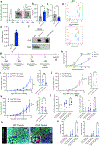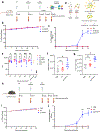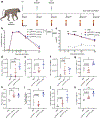Development of an engineered extracellular vesicles-based vaccine platform for combined delivery of mRNA and protein to induce functional immunity
- PMID: 39146981
- PMCID: PMC11978227
- DOI: 10.1016/j.jconrel.2024.08.017
Development of an engineered extracellular vesicles-based vaccine platform for combined delivery of mRNA and protein to induce functional immunity
Abstract
mRNA incorporated in lipid nanoparticles (LNPs) became a new class of vaccine modality for induction of immunity against COVID-19 and ushered in a new era in vaccine development. Here, we report a novel, easy-to-execute, and cost effective engineered extracellular vesicles (EVs)-based combined mRNA and protein vaccine platform (EVX-M+P vaccine) and explore its utility in proof-of-concept immunity studies in the settings of cancer and infectious disease. As a first example, we engineered EVs, natural nanoparticle carriers shed by all cells, to contain ovalbumin mRNA and protein (EVOvaM+P vaccine) to serve as cancer vaccine against ovalbumin-expressing melanoma tumors. EVOvaM+P administration to mice with established melanoma tumors resulted in tumor regression associated with effective humoral and adaptive immune responses. As a second example, we generated engineered EVs that contain Spike (S) mRNA and protein to serve as a combined mRNA and protein vaccine (EVSpikeM+P vaccine) against SARS-CoV-2 infection. EVSpikeM+P vaccine administration in mice and baboons elicited robust production of neutralizing IgG antibodies against RBD (receptor binding domain) of S protein and S protein specific T cell responses. Our proof-of-concept study describes a new platform with an ability for rapid development of combination mRNA and protein vaccines employing EVs for deployment against cancer and other diseases.
Copyright © 2024. Published by Elsevier B.V.
Conflict of interest statement
Declaration of competing interest MD Anderson Cancer Center and RK have filed patent applications and patents issued in the area of exosome biology, and some of them are licensed to PranaX, Inc. for non-cancer related use. MD Anderson and RK hold equity in PranaX and RK serves as an advisor on non-cancer related matters.
Figures




References
-
- Van Niel G, d’Angelo G, Raposo G, Shedding light on the cell biology of extracellular vesicles, Nat. Rev. Mol. Cell Biol 19 (4) (2018) 213–228. - PubMed
MeSH terms
Substances
Grants and funding
LinkOut - more resources
Full Text Sources
Medical
Research Materials
Miscellaneous

